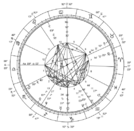Unsolved:Leo (astrology)
| Leo | |
|---|---|
| Zodiac symbol | Lion |
| Duration (tropical, western) | July 22 – August 22 (2024, UT1)[1] |
| Constellation | constellation of Leo |
| Zodiac element | Fire |
| Zodiac quality | Fixed |
| Sign ruler | Sun |
| Detriment | Uranus (ancient), Saturn (modern) |
| Exaltation | Pluto |
| Fall | Neptune |
| Astrology |
|---|
| Background |
| Traditions |
| Branches |
Leo (♌) (Greek: Λέων, Leōn), is the fifth astrological sign of the zodiac, originating from the constellation of Leo. It comes after Cancer and before Virgo. The traditional Western zodiac associates Leo with the period between July 23 and August 22,[2] and the sign spans the 120th to 150th degree of celestial longitude.
Leo is a fixed sign along with Taurus, Scorpio, and Aquarius. Under the tropical zodiac, the Sun transits this area on average between July 23 and August 22 each year, and under the sidereal zodiac, the Sun currently transits this area from approximately August 16 to September 15.[3] The symbol of the lion is based on the Nemean lion, a lion with an impenetrable hide.[4] It is a northern sign and its opposite southern sign is Aquarius.[2][5]
References
- ↑ Astronomical Applications Department 2011.
- ↑ 2.0 2.1 "Leo". Encyclopædia Britannica. United States: Encyclopædia Britannica, Inc.. 2017. https://www.britannica.com/place/Leo-constellation. Retrieved June 17, 2017.
- ↑ Swift, Jackson (2015). "Astrology: Tropical Zodiac and Sidereal Zodiac". goarticles.com. http://www.searcharticles.net/article.cfm/id/389534.
- ↑ Atsma, Aaron J.. "Nemean Lion". The Theoi Project: Greek mythology. http://www.theoi.com/Ther/LeonNemeios.html. Retrieved July 27, 2016.
- ↑ "Leo". Windows to the Universe. Arlington, Virginia: National Science Teachers Association. http://www.windows2universe.org/mythology/nemean_lion.html. Retrieved July 27, 2016.
Sources
- Astronomical Applications Department (2011), Multiyear Computer Interactive Almanac, 2.2.2., Washington DC: US Naval Observatory Longitude of Sun, apparent geocentric ecliptic of date, interpolated to find time of crossing 0°, 30°....
External links




